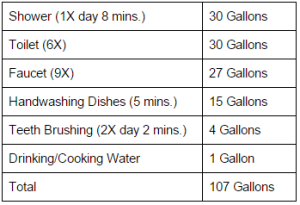1A- Living in northeast Philadelphia, I was lucky enough to find an abundant amount of information on my city’s water right from the city’s website. Philadelphia Water Department (PWD) strives to make the water surpass the minimums required by the state of Pennsylvania. The main characteristics of Philadelphia’s tap water include chloride, hardness, pH, corrosion inhibitor, and fluoride. Our water comes from the Delaware or Schuykill River and is placed in basins to settle. Then chlorine is added to disinfect the water. The amount of chlorine is based on the area in which you live as well as the weather outside. Chemicals are added in order for the water to coagulate, flocculate, and then settle and be removed. The water goes through filtration stations to purify it more. Finally, fluoride, zinc, and ammonia are added in order to prevent tooth decay, piping erosion, and to reduce chlorine taste. After we use this water in our homes through multiple appliances, where does it go? Depending on where in the city you live, you can either have a combined sewer system or a separate sewer system. It is up to the PWD to filter the waste water and return it back to the rivers. 98% of waste water is returned to the rivers through pumping, screening, removal, settling, and disinfection. The other 2% of water is overflow and returned through CSO or combined sewer overflow.
1B-
1C- After the experiment, I realized I use a lot of water in the bathroom. Drinking and cooking was not that much of an issue, but I see how different it is to fill up a glass of water compared to having an 8 minute shower. To cut back, I would definitely have to spend less time cleaning myself and other things. I wouldn’t be able to brush my teeth, shower, or wash dishes. I wouldn’t be able to flush the toilet at all considering it uses 3-5 gallons a flush (depending on the sources online). I decided that I would spend my two gallons on one face/hand wash and my average drinking/cooking water. I would not be able to do this considering I have to use the bathroom in order to be accepted in our society. Personal hygiene would have to be ignored if I only had 2 gallons of water a day. That’s how other people in 3rd world countries live and I would definitely not be able to do that. Our water sources depend on our economy and resources and how much money we can actually allot to water resources. I live in a city, I am able to use a lot of water because we don’t have a shortage. People in high drought areas or 3rd world countries do not have this privilege.
http://www.phila.gov/water/wu/drinkingwater/treatment/Pages/default.aspx http://www.phila.gov/water/wu/drinkingwater/FAQ/Pages/default.aspx
http://www.phillywatersheds.org/watershed_issues/stormwater_management/faq
http://www.phila.gov/water/PublishingImages/WaterDiagramPoster.jpg


Hey Nicolina, your blog post caught my eye because I am from a suburb of Philadelphia. In Abington, our water also comes from the Schuykill River, but I couldn’t find the vast information that you were able to find about the water conditions. They are very interesting and important to know about one’s own water source. Here is a link to my own blog post: http://geog030.dutton.psu.edu/2016/02/09/water-resources/. My Part C was similar to yours, also. I agree that in order to cut water, we would not be able to flush the toilet as much as we do.
Hi Nicolina! I’m Jessica and here’s my blog if you’re interested in reading it: http://geog030.dutton.psu.edu/2016/02/08/bucks-county-water-supply-jessica-moritz/#comment-22094
Your blog caught my eye because I live about a half hour from you so my water supply comes from Philadelphia also. When doing my researcher, I learned that the Delaware and Schuykill Rivers filter 546 million gallons per day combined! I thought that was insane but with all the people in the city it makes sense. I also liked how you noticed that most of the water you personally used was in the bathroom. In our society, it is almost impossible to just use 2 gallons of water per day, however, with some adjustments we could easily use less.